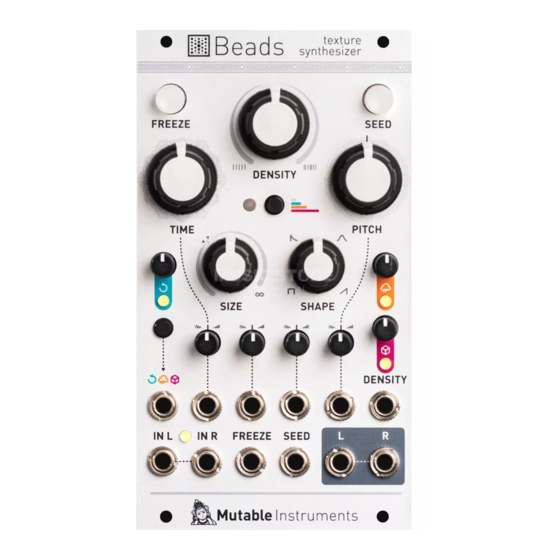Advertisement
Quick Links
Advertisement

Subscribe to Our Youtube Channel
Summary of Contents for Mutable Instruments Beads
- Page 1 Beads Texture synthesizer...
-
Page 2: Installation
Once upon a time there was Clouds. Then came the day to clean up the mess. Beads is a granular audio processor. It creates textures and soundscapes by playing back layered, delayed, transposed and enveloped fragments of sound (“grains”) taken continu- ously from the incoming audio signal. - Page 3 And there’s a reverb... Beads does not use tape, but RAM. In this manual we use computer-science terminology and refer to this virtual...
- Page 4 24 kHz 8-bit cassette • The Cold digital setting most accurately reproduces the sonic character of the late Mutable Instruments Clouds. • The Sunny tape setting runs the dry audio signal at a bright and clean 48kHz. • The Scorched cassette setting emulates wow and...
- Page 5 Beads operates in mono or stereo depending on whether one, or both, of the audio inputs are patched. When patch cables are inserted or removed, Beads monitors for five seconds the level of the incoming signal and adjusts the input gain accordingly, from +0dB to +32dB. The input level LED blinks during this adjustment process.
- Page 6 Grain generation Latched Latched grain generation is enabled by holding the SEED button for four seconds, or by pressing the FREEZE but- while the SEED button is being held. This is also the default setting when the module is powered on. The SEED button remains illuminated, and its brightness is slowly modulated to indicate that latching is enabled.
- Page 7 In this mode, the grains are generated continuously, at a rate set by the DENSITY knob and modulated by the DENSITY CV input (5). At 12 o’clock, no grains are generated. Turn DENSITY CW and grains will be generated at a randomly modulated rate, or CCW for a constant generation rate.
- Page 8 Grain playback control Four parameters control at which buffer position, pitch, and with which duration and envelope the grains are replayed. More precisely, these parameters and their respective modulations are read once, whenever a grain starts, and remain unchanged throughout the duration of the grain. If a parameter then changes, it will only impact the next grain.
- Page 9 Turn CW to increase grain duration up to 4s. Turn CCW to play a reversed grain, lasting up to 4s. Turning SIZE fully clockwise (∞) generates never-ending grains acting as delay taps. Please refer to the “Beads as a delay” section. SHAPE adjusts the amplitude envelope of the grain.
- Page 10 Attenurandomizers When a cable is patched into the corresponding CV input (6), turning the attenurandomizer CW from 12 o’clock increases the amount of external CV modulation. Turning it CCW increases the amount of CV-controlled randomization. With no CV patched into an input, the attenurandomizer con- trols the amount of randomization from an independent in- ternal random source with a peaky (12 o’clock to fully CCW) or uniform (12 o’clock to fully CW) distribution.
-
Page 11: Patch Ideas
Patch ideas • Patch a ramp-down LFO, or a decaying linear envelope into the TIME CV input for “scrubbing” the buffer, or a segment of it, at whichever speed the LFO rate or enve- lope time is set to. Timestretching time! •... - Page 12 Mixing and audio output Beads’ signal flow is as follows: grains reverb feedback dry/wet crossfade...
- Page 13 CV modulation. Audio output. While the recording buffer can be mono or stereo, Beads’ signal processing chain is always stereo. If the R output is left unpatched, both L and R signals are summed together and sent to the L output.
- Page 14 Beads as a delay Setting the grain SIZE knob fully clockwise (∞) turns Beads into a delay or beat slicer. Effectively, only one grain remains active, forever, continuously reading from the tape. The base delay time (and slice duration) can be manually controlled, tapped, or set by an external clock.
- Page 15 1/16 DENSITY Delaying or slicing When FREEZE is not engaged, Beads operates as a delay. The TIME knob selects the actual delay time, as a multiple of the base delay time set by DENSITY and/or by the external clock or taps.
- Page 16 Beads as a granular wavetable synth When both audio inputs are left unpatched, and at the end of a period of ten seconds, Beads loses patience and granularizes a collection of internally stored buffers of raw waveforms from Mutable Instruments Plaits’ wavetable model.









Need help?
Do you have a question about the Beads and is the answer not in the manual?
Questions and answers